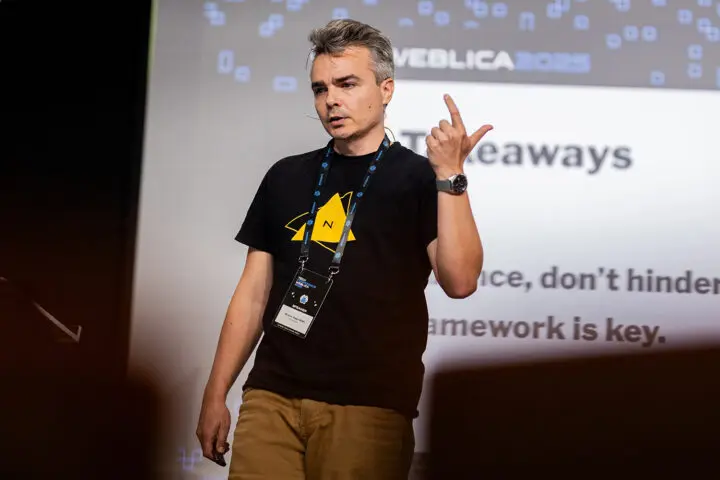Micro-interactions, macro-anxiety: a speaker’s view from Weblica conference
Last friday, I had the privilege of closing out Weblica 2025 as the final speaker of the day. For those unfamiliar, Weblica is a respected regional web technology conference held in Croatia’s picturesque Međimurje region. As someone who typically works behind the scenes on conferences, doing video production and live streaming, stepping onto the stage at 6:30 PM to deliver my presentation was both exhilarating and nerve-wracking.
More than just talks
Dom kulture Štrigova provided an impressive backdrop for this year’s event. The cultural center, with its modern hall of around 250 seats, was filled with web developers, designers, and technology enthusiasts from across the region. What struck me immediately was the professional yet relaxed atmosphere that filled the venue.

The organizers clearly understood that great conferences are about the complete experience. In my opinion Weblica simply can’t (and doesn’t need to) compete with huge conferences from Zagreb or the coast, so they smartly went via the boutique route – making the attendees feel as comfortable as possible. There were no major crowds so one could walk around freely, the food provided by Full Circle was exceptional (with no waiting lines), Garden Brewery kept the craft beers flowing, and barista Bruno Jelić deserves special recognition for consistently serving some of the best coffee I’ve ever had at a tech event. I just couldn’t stop savoring those Cortados. These details might seem small, but they created natural spaces for networking and discussion between sessions.
The technical production was equally impressive – crisp audio throughout the day, clear visuals, and a seamless experience for both speakers and attendees. This attention to detail allowed everyone to focus entirely on the content being shared.
Standout sessions
What made Weblica particularly refreshing was the absence of sales pitches disguised as presentations. Instead, the day was filled with practical insights and genuine knowledge sharing.
The conference kicked off with a thought-provoking keynote by Luka Kladarić titled “Why are databases so difficult?” He demystified the complexities of database management, explaining how they operate under known limitations that have become almost arcane knowledge as the barrier to entry in software development continues to drop.

Another highlight was Gordon Cindrić and Anja Logožar’s session on integrating UX into Agile development. Their practical strategies for raising UX maturity in teams without inflating budgets or timelines resonated with many attendees, myself included. Their focus on avoiding “solutioneering” and keeping processes user-centered rather than assumption-driven complemented many of the points I would later make in my own presentation.
My presentation: beasts of burden
As the day’s final speaker, I took the stage to deliver my talk: “Beasts of burden: how motion design transforms UX.” The talk explored how microinteractions can enhance user experience, strengthen brand identity, and drive website performance, particularly in eCommerce contexts.
I packed my talk with real-world examples of effective microinteractions from apps we all use daily like when Uber confirms your ride or the iconic wave visualization in Shazam. These small moments of feedback are what transform good digital experiences into memorable ones.
The highlight for many attendees was my 5-minute video demonstration of creating an animation in After Effects and exporting it as a JSON file, followed by showing exactly how a developer would implement that file on a website. This bridge between design and development seemed to click with the audience.
A significant portion of my presentation focused on practical techniques that attendees could implement immediately:
- Exporting animations as JSON files to dramatically reduce file size while maintaining quality
- How JSON animations can significantly improve website performance and lower bounce rates
- The platform-agnostic nature of these animations, allowing them to work across different systems
- The ability to scale these animations without quality loss
- How PM and development teams can adapt these animations in real-time through code
By failing to prepare, you’re preparing to fail
As an introvert, public speaking doesn’t come naturally to me. I spent days preparing this presentation, refining my slides and creating demonstration materials using After Effects and Premiere Pro. I knew that thorough homework was my best defense against nervousness. Despite my preparation, I still found myself drinking copious amounts of water to combat dry mouth – a telltale sign of public speaking anxiety. But as the presentation progressed and I saw heads nodding in agreement, my confidence grew. By the time I reached my workflow demonstration, I was fully in my element, sharing the craft I’m passionate about.
Connections made
One of the most valuable aspects of Weblica was the opportunity to connect with professionals from companies like Infinum, McKnight Media, and Prototype. I was particularly touched with the LinkedIn feedback regarding my presentation: “Great talk and tons of useful tips. Loved the process part too.” It’s this kind of validation that makes stepping outside your comfort zone worthwhile.

Speaking at Weblica was more than just an opportunity to share knowledge – it was a personal challenge I set for myself. As someone who typically works behind the scenes, putting myself in the spotlight required confronting some fears. Would I do anything differently? Honestly, no. The experience, from preparation to delivery, felt authentic to who I am – and what I wanted to share.







